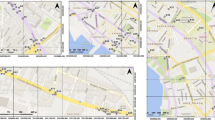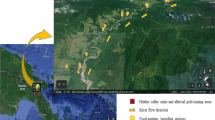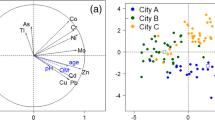Abstract
Urban agriculture should be promoted as long as the food produced is safe for consumption. Located in the metropolitan region of São Paulo-Brazil, Santo André has intense industrial activities and more recently an increasing stimulus to urban gardening. One of the potential risks associated to this activity is the presence of potentially toxic elements (PTEs). In this study, the concentration of PTEs (As, Ba, Cd, Co, Cu, Cr, Ni, Mo, Pb, Sb, Se, V and Zn) was evaluated by soil (n = 85) and soil amendments (n = 19) in urban gardens from this municipality. Only barium was above regulatory limits in agricultural soil ranging from 20 to 112 mg kg−1. Geochemical indexes (Igeo, Cf and Er) revealed moderate to severe pollution for As, Ba, Cr, Cu, Pb Se and Zn, especialy in Capuava petrochemical complex gardens. A multivariate statistical approach discriminated Capuava gardens from the others and correlated As, Cr and V as main factors of pollution. However, carcinogenic and non-carcinogenic risks were below the acceptable range for regulatory purposes of 10–6–10–4 for adults. Soil amendments were identified as a possible source of contamination for Ba, Zn and Pb which ranged from 37 to 4137 mg kg−1, 20 to 701 mg kg−1 and 0.7 to 73 mg kg−1, respectively. The results also indicated the presence of six pathogenic bacteria in these amendments. Besides that, the occurrence of antimicrobial resistance for Shigella, Enterobacter and Citrobacter isolates suggests that soil management practices improvement is necessary.




Similar content being viewed by others
References
Alfaro, M. R., Do Nascimento, C. W. A., Ugarte, O. M., Álvarez, A. M., de Aguiar Accioly, A. M., Martín, B. C., & Aguilar, M. G. (2017). First national-wide survey of trace elements in Cuban urban agriculture. Agronomy for Sustainable Development, 37(4), 1–7. https://doi.org/10.1007/s13593-017-0437-7
Amato-Lourenço, L. F., Buralli, R. J., Ranieri, G. R., Hearn, A. H., Williams, C., & Mauad, T. (2021). Building knowledge in urban agriculture: The challenges of local food production in Sao Paulo and Melbourne. Environment, Development and Sustainability, 23(2), 2785–2796. https://doi.org/10.1007/s10668-020-00636-x
Bloem, E., Albihn, A., Elving, J., Hermann, L., Lehmann, L., Sarvi, M., & Ylivainio, K. (2017). Contamination of organic nutrient sources with potentially toxic elements, antibiotics and pathogen microorganisms in relation to P fertilizer potential and treatment options for the production of sustainable fertilizers: A review. Science of the Total Environment, 607, 225–242. https://doi.org/10.1016/j.scitotenv.2017.06.274
Brazil. PORTARIA Nº 467, DE 7 DE FEVEREIRO DE 2018 - Institui o Programa Nacional de Agricultura Urbana e Periurbana. https://www.jusbrasil.com.br/diarios/177346593/dou-secao-1-09-02-2018-pg-64 Accessed 25 Feb 2022.
Brazil Ministry of agriculture, livestock and supply. Normative instruction n. 5 of 10 March 2016, Distrito federal http://www.agricultura.gov.br/assuntos/insumos-agropecuarios/insumos-agricolas/fertilizantes/legislacao/in-5-de-10-3-16-remineralizadores-e-substratos-para-plantas.pdf
Camargo, O. A., Moniz, A. C., Jorge, J. A., & Valadares, J. M. A. S. (2009). Métodos de análise química, mineralógica e física de solos do Instituto Agronômico de Campinas [Methods of Chemical, Mineralogical and Soil Physics Analysis of the Agronomic Institute of Campinas]. Technical Bulletin, 106, 94.
Caumo, S., Vicente, A., Custódio, D., Alves, C., & Vasconcellos, P. (2018). Organic compounds in particulate and gaseous phase collected in the neighbourhood of an industrial complex in São Paulo (Brazil). Air Quality, Atmosphere and Health, 11(3), 271–283. https://doi.org/10.1007/s11869-017-0531-7
CETESB Environmental Company of the State of São Paulo. Guiding Values for soils and water underground in the State of São Paulo (2016). https://cetesb.sp.gov.br/aguas-subterraneas/wpcontent/uploads/sites13/2013/11/tabela_vos_2016_site.pdf. Accessed 09 June 2022
CLSI - Clinical and Laboratory Standards Institute (2008). Performance standards for antimicrobial disk and dilution susceptibility tests for bacteria isolated from animals, approved standard, CLSI document M31-A3. 3rd ed. CLSI, Wayne, PA.
CLSI - Clinical and Laboratory Standards Institute, 2018. Performance Standards for Antimicrobial Susceptibility Testing: Twenty-third Informational Supplement M100-S23. CLSI, Wayne, PA.
Ćwieląg-Drabek, M., Piekut, A., Gut, K., & Grabowski, M. (2020). Risk of cadmium, lead and zinc exposure from consumption of vegetables produced in areas with mining and smelting past. Scientific Reports, 10(1), 1–9. https://doi.org/10.1038/s41598-020-60386-8
Dala-Paula, B. M., Custódio, F. B., Knupp, E. A., Palmieri, H. E., Silva, J. B. B., & Glória, M. B. A. (2018). Cadmium, copper and lead levels in different cultivars of lettuce and soil from urban agriculture. Environmental Pollution, 242, 383–389. https://doi.org/10.1016/j.envpol.2018.04.101
Deelstra, T., & Girardet, H. (2000). Urban agriculture and sustainable cities. Bakker N., Dubbeling M., Gündel S., Sabel-Koshella U., de Zeeuw H. Growing cities, growing food. Urban agriculture on the policy agenda. Feldafing, Germany: Zentralstelle für Ernährung und Landwirtschaft (ZEL), 43–66.
DENATRAN – DEPARTAMENTO NACIONAL DE TRÂNSITO. Estatísticas, 2019. Available in: http://www.denatran.gov.br/frota. Accessed 14 Mar 2020.
Element, C. A. S. (2007). Method 3051A microwave assisted acid digestion of sediments, sludges, soils, and oils. Z. Für Anal. Chem, 111, 362–366.
EMBRAPA. Manual de métodos de análise de solo/Centro Nacional de Pesquisa de Solos (2a. ed), Empresa Brasileira de Pesquisa Agropecuária. Centro Nacional de Pesquisa de Solos, rev. revista. – Rio de Janeiro, 225p, 2011.
Ewing, W. H. (1986). Edwards and Ewing's identification of Enterobacteriaceae. Edwards and Ewing's Identification of Enterobacteriaceae., (Edition 4).
Fernández-de-Sevilla, T., & dalla Costa, A. J. (2019). Catching the ladder: The formation and growth of the São Paulo automotive industry cluster 1. In Regional Economic Development and History (pp. 119–144). Routledge.
Figueiredo, A. M. G., Tocchini, M., & dos Santos, T. F. (2011). Metals in playground soils of Sao Paulo city, Brazil. Procedia Environmental Sciences, 4, 303–309.
Freire, B. M., Gonzaga, R. G., Pedron, T., Monteiro, L. R., Lange, C. N., Pedreira Filho, W. D. R., & Batista, B. L. (2021). Occupational exposure to potentially toxic elements in the foundry industry: An integrated environmental and biological monitoring. Environmental Science and Pollution Research, 28(26), 34630–34641. https://doi.org/10.1007/s11356-021-13099-y
Gabarrón, M., Faz, A., & Acosta, J. A. (2017). Soil or dust for health risk assessment studies in urban environment. Archives of Environmental Contamination and Toxicology, 73(3), 442–455. https://doi.org/10.1007/s00244-017-0413-x
Grimm, D., & Wösten, H. A. (2018). Mushroom cultivation in the circular economy. Applied Microbiology and Biotechnology, 102(18), 7795–7803. https://doi.org/10.1007/s00253-018-9226-8
Hakanson, L. (1980). An ecological risk index for aquatic pollution control: A Sedimentological Approach. Water Research, 14(8), 975–1001. https://doi.org/10.1016/0043-1354(80)90143-8
Han, D., Luo, D., Chen, Y., & Wang, G. (2013). Transfer of Cd, Pb, and Zn to water spinach from a polluted soil amended with lime and organic materials. Journal of Soils and Sediments, 13(8), 1360–1368. https://doi.org/10.1007/s11368-013-0711-5
Hu, T., Zhang, J., Ye, C., Zhang, L., Xing, X., Zhang, Y., & Zhang, Q. (2017). Status, source and health risk assessment of polycyclic aromatic hydrocarbons (PAHs) in soil from the water-level-fluctuation zone of the Three Gorges Reservoir, China. Journal of Geochemical Exploration, 172, 20–28. https://doi.org/10.1016/j.ecoenv.2014.04.031
IBGE – Instituto Brasileiro de Geografia e Estatística (2013). Pesquisa Nacional por Amostra de Domicílios: Segurança alimentar 2013, Rio de Janeiro. https://biblioteca.ibge.gov.br/visualizacao/livros/
IBGE – Instituto Brasileiros de Geografia e Estatística (2015). Pesquisa Nacional por Amostra de Domicílios. Brasília: IBGE, 2015.
Jordan, S. N., Mullen, G. J., & Murphy, M. C. (2008). Composition variability of spent mushroom compost in Ireland. Bioresource Technology, 99(2), 411–418. https://doi.org/10.1016/j.biortech.2006.12.012
Kalembasa, D., & Wiśniewska, B. (2009). Influence of mushroom substrate on lithium, barium and strontium contents at Italian ryegrass. Ecological Chemistry and Engineering A, 16(4), 357–363.
Laidlaw, M. A., Alankarage, D. H., Reichman, S. M., Taylor, M. P., & Ball, A. S. (2018). Assessment of soil metal concentrations in residential and community vegetable gardens in Melbourne, Australia. Chemosphere, 199, 303–311. https://doi.org/10.1016/j.chemosphere.2018.02.044
Lange, C. N., Figueiredo, A. M. G., Enzweiler, J., & Castro, L. (2017). Trace elements status in the terrain of an impounded vehicle scrapyard. Journal of Radioanalytical and Nuclear Chemistry, 311(2), 1323–1332. https://doi.org/10.1007/s10967-016-5078-9
Manno, E., Varrica, D., & Dongarrà, G. (2006). Metal distribution in road dust samples collected in an urban area close to a petrochemical plant at Gela. Sicily. Atmospheric Environment, 40(30), 5929–5941. https://doi.org/10.1016/j.atmosenv.2006.05.020
Margenat, A., You, R., Cañameras, N., Carazo, N., Díez, S., Bayona, J. M., & Matamoros, V. (2020). Occurrence and human health risk assessment of antibiotics and trace elements in Lactuca sativa amended with different organic fertilizers. Environmental Research, 190, 109946. https://doi.org/10.1016/j.jhazmat.2020.123424
Marquès, M., Domingo, J. L., Nadal, M., & Schuhmacher, M. (2020). Health risks for the population living near petrochemical industrial complexes: 2—Adverse health outcomes other than cancer. Science of the Total Environment, 730, 139122. https://doi.org/10.1016/j.scitotenv.2020.139122
McBride, M. B., Shayler, H. A., Spliethoff, H. M., Mitchell, R. G., Marquez-Bravo, L. G., Ferenz, G. S., & Bachman, S. (2014). Concentrations of lead, cadmium and barium in urban garden-grown vegetables: The impact of soil variables. Environmental Pollution, 194, 254–261. https://doi.org/10.1016/j.envpol.2014.07.036
Medina, E., Paredes, C., Bustamante, M. A., Moral, R., & Moreno-Caselles, J. (2012). Relationships between soil physico-chemical, chemical and biological properties in a soil amended with spent mushroom substrate. Geoderma, 173, 152–161. https://doi.org/10.1016/j.geoderma.2011.12.011
Mohd Hanafi, F. H., Rezania, S., Mat Taib, S., Md Din, M. F., Yamauchi, M., Sakamoto, M., & Ebrahimi, S. S. (2018). Environmentally sustainable applications of agro-based spent mushroom substrate (SMS): An overview. Journal of Material Cycles and Waste Management, 20(3), 1383–1396. https://doi.org/10.1007/s10163-018-0739-0
Mougeot, L. (2015). Urban agriculture in cities of the Global South: four logics of integration. Food and the city: Histories of culture and cultivation, 163–193.
Müller, G. (1969). Index of geoaccumulation in sediments of the Rhine River. GeoJournal, 2, 108–118.
Nabulo, G., Black, C. R., Craigon, J., & Young, S. D. (2012). Does consumption of leafy vegetables grown in peri-urban agriculture pose a risk to human health? Environmental Pollution, 162, 389–398. https://doi.org/10.1016/j.envpol.2011.11.040
Palansooriya, K. N., Shaheen, S. M., Chen, S. S., Tsang, D. C., Hashimoto, Y., Hou, D., & Ok, Y. S. (2020). Soil amendments for immobilization of potentially toxic elements in contaminated soils: A critical review. Environment International, 134, 105046. https://doi.org/10.1016/j.envint.2019.105046
Paniz, F. P., Pedron, T., Freire, B. M., Torres, D. P., Silva, F. F., & Batista, B. L. (2018). Effective procedures for the determination of As, Cd, Cu, Fe, Hg, Mg, Mn, Ni, Pb, Se, Th, Zn, U and rare earth elements in plants and foodstuffs. Analytical Methods, 10(33), 4094–4103. https://doi.org/10.1039/C8AY01295D
Paradelo, R., Villada, A., & Barral, M. T. (2020). Heavy metal uptake of lettuce and ryegrass from urban waste composts. International Journal of Environmental Research and Public Health, 17(8), 2887. https://doi.org/10.3390/ijerph17082887
Van Raij, B. (2011). Melhorando o ambiente radicular em subsuperfície. Informações Agronômicas, 135. https://www.ipni.net/publication/ia-brasil.nsf/0/07522979282F212C83257A8F005D7C7D/$FILE/Page8-18-135.pdf
Roese, A. D., & Curado, F. F. (2004). A contribuição da agricultura urbana na segurança alimentar comunitária em Corumbá e Ladário, MS. IV Simpósio sobre recursos naturais e socioeconômicos do pantanal. Corumbá/MS-23–26 nov.
Ross, M. A. (2009). Integrated science assessment for particulate matter. US Environmental Protection Agency: Washington DC, USA, 61-161.
Salomon, M. J., Watts-Williams, S. J., McLaughlin, M. J., & Cavagnaro, T. R. (2020). Urban soil health: A city-wide survey of chemical and biological properties of urban agriculture soils. Journal of Cleaner Production, 275, 122900.
Sant’Anna, P. B., de Melo Franco, B. D., & Maffei, D. F. (2020). Microbiological safety of ready-to-eat minimally processed vegetables in Brazil: An overview. Journal of the Science of Food and Agriculture, 100(13), 4664–4670. https://doi.org/10.1002/jsfa.10438
Sant’anna-de-Medeiros, N., do-Carmo, D. L., Priore, S. E., & Santos, R. H. S. (2020). Diverse food in urban gardens in the promotion of food and nutrition security in Brazil: a review. Journal of the Science of Food and Agriculture, 100(4), 1383–1391. https://doi.org/10.1002/jsfa.10127
Schram-Bijkerk, D., Otte, P., Dirven, L., & Breure, A. M. (2018). Indicators to support healthy urban gardening in urban management. Science of the Total Environment, 621, 863–871. https://doi.org/10.1016/j.scitotenv.2017.11.160
Segura, F. R., Nunes, E. A., Paniz, F. P., Paulelli, A. C. C., Rodrigues, G. B., Braga, G. Ú. L., & Batista, B. L. (2016). Potential risks of the residue from Samarco’s mine dam burst (Bento Rodrigues, Brazil). Environmental Pollution, 218, 813–825. https://doi.org/10.1016/j.envpol.2016.08.005
Smieja-Król, B., Pawlyta, M., & Gałka, M. (2022). Ultrafine multi-metal (Zn, Cd, Pb) sulfide aggregates formation in periodically water-logged organic soil. Science of the Total Environment, 820, 153308. https://doi.org/10.1016/j.scitotenv.2022.153308
Solos, E. (2013). Sistema brasileiro de classificação de solos. Centro Nacional de Pesquisa de Solos.
Spliethoff, H. M., Mitchell, R. G., Shayler, H., Marquez-Bravo, L. G., Russell-Anelli, J., Ferenz, G., & McBride, M. (2016). Estimated lead (Pb) exposures for a population of urban community gardeners. Environmental Geochemistry and Health, 38(4), 955–971.
Steiner, M. D., & Grieder, S. G. (2020). EFAtools: An R package with fast and flexible implementations of exploratory factor analysis tools. Journal of Open Source Software, 5(53), 2521. https://doi.org/10.21105/joss.02521
Suda, A., & Makino, T. (2016). Functional effects of manganese and iron oxides on the dynamics of trace elements in soils with a special focus on arsenic and cadmium: A review. Geoderma, 270, 68–75. https://doi.org/10.1016/j.geoderma.2015.12.017
Toledo, M. R. F. D., Fontes, C. F., & Trabulsi, L. R. (1982a). EPM-A modification of Rugai and Araujo medium for simultaneous test of gas production from glucose, H2S, urease and tryptophan deaminase. Revista De Microbiologia, 13, 309–315.
Toledo, M. R. F., Fontes, C. F., & Trabulsi, L. R. (1982b). MI: A medium for detection of motilily, 468 indole, and lysine decarboxylase. Revista De Microbiologia, 13, 230–235.
United Nations, Department of Economic and Social Affairs, Population Division (2019). World Population Prospects 2019: Data Booklet (ST/ESA/SER.A/424).
Urra, J., Alkorta, I., & Garbisu, C. (2019). Potential benefits and risks for soil health derived from the use of organic amendments in agriculture. Agronomy, 9(9), 542. https://doi.org/10.3390/agronomy9090542
USEPA (1989). Risk assessment guidance for superfund volume I human health evaluation manual (Part A). Office of Emergency and Remedial Response. U.S. Environmental Protection Agency Washington, 20450. EPA/540/1-89/002.
USEPA (2004). Risk assessment guidance for superfund volume I: human health evaluation manual (Part E, Supplemental Guidance for Dermal Risk Assessment). Office of Superfund Remediation and Technology Innovation U.S. Environmental Protection Agency Washington, EPA/540/R/99/005.
Uzu, G., Schreck, E., Xiong, T., Macouin, M., Lévêque, T., Fayomi, B., & Dumat, C. (2014). Urban market gardening in Africa: Foliar uptake of metal (loid) s and their bioaccessibility in vegetables; implications in terms of health risks. Water, Air, & Soil Pollution, 225(11), 1–13. https://doi.org/10.1007/s11270-014-2185-5
Weber, A. M., Mawodza, T., Sarkar, B., & Menon, M. (2019). Assessment of potentially toxic trace element contamination in urban allotment soils and their uptake by onions: A preliminary case study from Sheffield, England. Ecotoxicology and Environmental Safety, 170, 156–165. https://doi.org/10.1016/j.ecoenv.2018.11.090
Wiseman, C. L., Zereini, F., & Püttmann, W. (2013). Traffic-related trace element fate and uptake by plants cultivated in roadside soils in Toronto, Canada. Science of the Total Environment, 442, 86–95. https://doi.org/10.1016/j.scitotenv.2012.10.051
Funding
The authors kindly thank Fundação de Amparo à Pesquisa do Estado de São Paulo (FAPESP, grant numbers 2014/05151-0, 2016/10060-9, 2020/00284-2, 2022/10619-7, 2022/00208-0, 2022/08618-2) and Conselho Nacional de Pesquisa grant 153204/2018-4. This study was funded in part by the Coordenação de Aperfeiçoamento de Pessoal de Nível Superior—Brazil (CAPES)—Finance Code 001.
Author information
Authors and Affiliations
Contributions
Camila Neves Lange done analysis and manuscript writing; Bruna Moreira Freire done soil analysis and manuscript writing; Lucilena Rebelo Monteiro helped in statistical analysis and manuscript writing; Tatiane Araújo de Jesus done soil sampling, Roberta Albino dos Reis helped in soil amendments analysis; Gerson Nakazato and Renata Katsuko Takayama Kobayashi done microbiological analysis; Bruno Lemos Batista helped in manuscript writing. All authors reviewed the manuscript.
Corresponding author
Ethics declarations
Conflict of interest
The authors have no conflicts of interest to declare that are relevant to the content of this article.
Additional information
Publisher's Note
Springer Nature remains neutral with regard to jurisdictional claims in published maps and institutional affiliations.
Supplementary Information
Below is the link to the electronic supplementary material.
Rights and permissions
Springer Nature or its licensor (e.g. a society or other partner) holds exclusive rights to this article under a publishing agreement with the author(s) or other rightsholder(s); author self-archiving of the accepted manuscript version of this article is solely governed by the terms of such publishing agreement and applicable law.
About this article
Cite this article
Lange, C.N., Freire, B.M., Monteiro, L.R. et al. Multiple potentially toxic elements in urban gardens from a Brazilian industrialized city. Environ Geochem Health 46, 36 (2024). https://doi.org/10.1007/s10653-023-01808-0
Received:
Accepted:
Published:
DOI: https://doi.org/10.1007/s10653-023-01808-0




